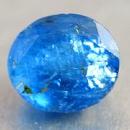|
|
||||||||||||||||
|
||||||||||||||||
|
||||||
|
|
|
|
Afghanite
|
|
| | |
| Discovered in 1968; IMA status: Valid (IMA approved 1968) | ||
|
| ||
|
Chemistry |
|
|
| |
|
(Na,Ca,K)8(Si,Al)12O24(SO4,Cl,CO3)3 · H2O | |
|
|
Hydrated Sodium Calcium Potassium Aluminum Silicate Carbonate |
|
Molecular Weight: |
1,200.45 gm |
|
Composition: |
Potassium |
2.28 % |
K |
2.75 % |
K2O |
|
|
Sodium |
9.19 % |
Na |
12.39 % |
Na2O |
|
|
Calcium |
11.69 % |
Ca |
16.35 % |
CaO |
|
|
Aluminum |
13.26 % |
Al |
25.06 % |
Al2O3 |
|
|
Silicon |
14.27 % |
Si |
30.53 % |
SiO2 |
|
|
Hydrogen |
0.08 % |
H |
0.75 % |
H2O |
|
|
Carbon |
0.10 % |
C |
0.37 % |
CO2 |
|
|
Sulfur |
3.39 % |
S |
8.47 % |
SO3 |
|
|
Chlorine |
4.58 % |
Cl |
4.58 % |
Cl |
|
|
|
— % |
Cl |
—1.03 % |
—O=Cl2 |
|
|
Oxygen |
41.16 % |
O |
|
|
|
|
|
100.00 % |
|
100.00 % |
= TOTAL OXIDE |
|
|
|
||||
|
Classification |
|
|
| |
|
Silicates (Germanates) | |
|
8/J.09-50 | |
|
|
9 : SILICATES (Germanates)
|
|
Related to: |
Cancrinite Group |
|
Members of Group: |
Cancrinite Group: Afghanite, Allorite, Biachellaite, Bystrite, Cancrinite, Cancrisilite, Davyne, Depmeierite, Franzinite, Giuseppetite, Hydroxycancrinite, Kircherite, Kyanoxalite, Liottite, Marinellite, Microsommite, Pitiglianoite, Quadridavyne, Sacrofanite, Tounkite, Vishnevite |
|
Varieties: |
None |
|
Synonyms: |
IMA1967-041 |
|
|
|
|
Crystal Data |
|
|
|
|
|
As stout to slender, thin tabular laths and as rounded grains or as massive - uniformly indistinguishable crystals forming large masses. |
|
|
None |
|
|
|
|
|
Physical Properties |
|
|
|
|
|
Perfect on [1010] |
|
|
Conchoidal |
|
|
Brittle |
|
|
5.5 - 6.0 |
|
|
2.55 - 2.65 (g/cm3) |
|
|
None |
|
|
Barely Detectable; GRapi = 32.54 (Gamma Ray American Petroleum Institute Units) |
|
|
|
|
|
Optical Properties |
|
|
|
|
|
Light Blue to Dark Blue, Colorless |
|
|
Transparent |
|
|
Vitreous |
|
|
1.523 - 1.529 Uniaxial ( + ) |
|
|
0.006 |
|
|
n/a |
|
|
None |
|
|
|
|
|
Occurances |
|
|
|
|
|
Geological Setting: |
In thin veinlets cutting lazurite crystals (Sar-e-Sang, Afghanistan); in silicifed limestone xenoliths in pumice (Pitigliano quarry, Italy). |
|
Common Associations: |
Lazurite, Sodalite, Nepheline, Phlogopite, Olivine, Diopside, Vesuvianite, Calcite, Pyrite. |
|
Common Impurities: |
None |
|
Type Locality: |
Lapis-lazuli Mine, Sar-e-Sang, Badakhshan (Badakshan; Badahsan) Province, Afghanistan |
|
Year Discovered: |
1968 |
|
View mineral photos: | |
|
|
|
|
More Information |
|
|
|
|
|
| |
|
|
|
|
Locations
for Afghanite: at Sar-e-Sang, Badakhshan Province, Afghanistan.
In Russia, in the Malaya Bystraya and Tultuy lazurite
deposits, near Lake Baikal, and in other unspecified
deposits in eastern Siberia. From Lyadzhuar-Darinsk,
Pamir Mountains, Tajikistan. In Italy, at the Pitigliano
quarry, near Grosseto, Tuscany; on Monte Somma, Campania;
from Vetralla and Bassano, Latium. In the Edwards mine,
Edwards, St. Lawrence County, New York, USA. At Lake
Harbour, Bafin Island, Newfoundland, Canada. |
|
|
We
have not photographed the Afghanite gems yet. Please
check back soon. |
